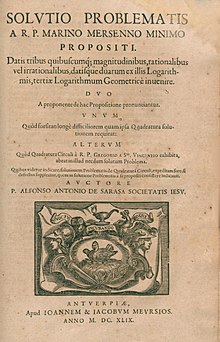| Part of a series on the |
| Society of Jesus |
|---|
 Christogram of the Jesuits Christogram of the Jesuits |
| History |
| Hierarchy |
| Spirituality |
| Works |
| Notable Jesuits |
|
|

Alphonse Antonio de Sarasa was a Jesuit mathematician who contributed to the understanding of logarithms, particularly as areas under a hyperbola.
Alphonse de Sarasa was born in 1618, in Nieuwpoort in Flanders. In 1632 he was admitted as a novice in Ghent. It was there that he worked alongside Gregoire de Saint-Vincent whose ideas he developed, exploited, and promulgated. According to Sommervogel, Alphonse de Sarasa also held academic positions in Antwerp and Brussels.
In 1649 Alphonse de Sarasa published Solutio problematis a R.P. Marino Mersenne Minimo propositi. This book was in response to Marin Mersenne's pamphlet "Reflexiones Physico-mathematicae" which reviewed Saint-Vincent's Opus Geometricum and posed this challenge:
- Given three arbitrary magnitudes, rational or irrational, and given the logarithms of the two, to find the logarithm of the third geometrically.
R.P. Burn explains that the term logarithm was used differently in the seventeenth century. Logarithms were any arithmetic progression which corresponded to a geometric progression. Burn says, in reviewing de Sarasa's popularization of de Saint-Vincent, and concurring with Moritz Cantor, that "the relationship between logarithms and the hyperbola was found by Saint-Vincent in all but name".
Burn quotes de Sarasa on this point: "…the foundation of the teaching embracing logarithms are contained" in Saint-Vincent's Opus Geometricum, part 4 of Book 6, de Hyperbola.
Alphonse Antonio de Sarasa died in Brussels in 1667.
Works
Sarasa, Alfonso Antonio (1649). Solutio problematis a R. P. Marino Mersenno minimo propositi, datis tribus quibuscumq[ue] magnitudinibus, rationalibus vel irrationalibus, datisque duarum ex illis logarithmis, tertiae logarithmum geometricè invenire. Jan van Meurs, Jacob van Meurs.
See also
References
- C.H. Edwards, Jr. (1979) The Historical Development of the Calculus, pp. 154–8, Springer-Verlag, ISBN 0-387-90436-0
- C. Sommervogel (1896) Bibliothèque de la Compagnie de Jésus, vol. VII, pp. 621–7
- Alphonse Antonio de Sarasa, Solutio problematis a R.P. Marino Mersenne Minimo propositi … , (Antwerp, (Belgium): Johannes and Jakob Meursius, 1649).
Sarasa realized that given a hyperbola and a pair of points along the abscissa which were related by a geometric progression, then if the abscissas of the points were multiplied together, the abscissa of their product had an area under the hyperbola which equaled the sum of the points' areas under the hyperbola. That is, the logarithm of an abscissa was proportional to the area, under a hyperbola, corresponding to that abscissa. This finding united the algebra of logarithms with the geometry of hyperbolic curves.- Sarasa's critical finding occurs on page 16 (near the bottom of the page), where he states: "Unde hae superficies supplere possunt locum logarithmorum datorum … " (Whence these areas can fill the place of the given logarithms … ).
- See also: Enrique A. González-Velasco, Journey through Mathematics: Creative Episodes in Its History (New York, New York: Springer, 2011), pp. 119-120.
- R. P. Burn (2001) "Alphonse Antonio de Sarasa and Logarithms", Historia Mathematica 28:1 – 17